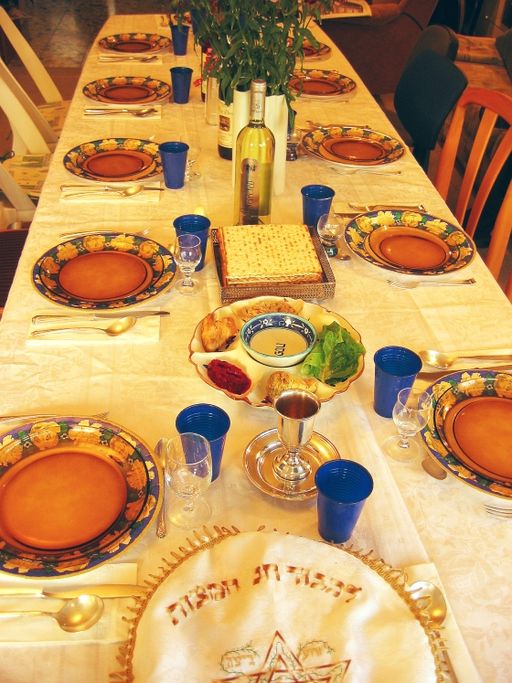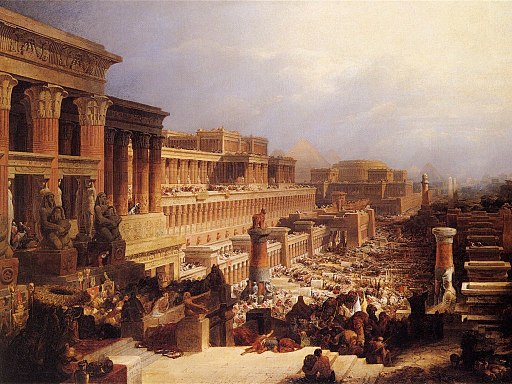Slavery, miracles, frogs, liberation and one Charlton Heston.
Welcome to Passover, the holiday that has it all – and much, much more.
- What is Passover?
- What does Passover mean?
- What are the origins of Passover?
- How do you celebrate Passover? What are the rituals and traditions of Passover?
- When Is Passover?
What is Passover?
Passover is one of the most important and sacred holidays in Judaism.
This holiday celebrates amazing miracles, liberation of the Israelites from slavery and the Exodus of the Israelites from Egypt.
During the existence of the Jerusalem Temple, it was one of the Three Pilgrimage Festivals. The Three Pilgrimage Festivals are three major festivals in Judaism (Passover, Shavuot, and Sukkot), when the ancient Israelites living in the Kingdom of Judah would make a pilgrimage to the Temple in Jerusalem, as commanded by the Torah (the Hebrew Bible).
The Passover begins on the 15th day of the first month of the Hebrew calendar, the month of Nisan. This means that usually Passover is celebrated during March or April.
It is celebrated for seven days in the Land of Israel and for eight days outside the Land of Israel.
What does Passover mean?
In Hebrew, the holiday is called Pesach, derived from the verb for “pass over”. Why? Since God passed over the homes of the Israelites on the night he killed every Egyptian firstborn.
Wait…. What?! Why?! How?!
Well, these are excellent questions.
You can find the full, exciting version of the story right here – Israelites in Egypt (part I) and Israelites in Egypt (part II).
Let’s go over the shorter version:
The Israelites (the ancient Jews) used to live in the Promised Land, then known as Canaan. Due to hunger in Canaan, the Israelites migrate to Egypt, and live peacefully for a while.
However, the ascension of a hostile Pharaoh means bad news for the Jews. The Egyptians enslave the Israelites (which they call Hebrews), having them do excruciating and backbreaking construction labor. And even worse, the Pharaoh also orders the slaughter at birth of all male Hebrew children. That really sucks…
Thankfully, one male Hebrew is placed in a basket on the river Nile. He is found and then adopted by Pharaoh’s daughter. And his name? Moses. That’s right, that Moses.

As a young man, Moses sees an Egyptian beating a Hebrew slave. Being a man of high morals, Moses protects the slave, whilst killing the Egyptian.
Without much choice, Moses flees to a place called Midian, but not for long. Soon after, God commands Moses to go back to Egypt, free the Hebrew slaves and bring them to the Promised Land of Canaan (Israel).
As you would expect, Mr. Hostile Pharaoh does not want to free his efficient slaves. Again and again Moses pleads “Let my people go, by the name of the God of Israel!”. And again and again Pharaoh refuses to do so, saying that he does not know the God of Israel.
So God introduces himself, in the most extravagant way there is – by inflicting nation wide disasters!
For each time that Moses goes to Pharaoh and Pharaoh refuses to release the Israelites, God inflicts a new disaster on Egypt. There are a total of ten disasters, known as “The Ten Plagues of Egypt”.
The last of the ten plagues is Death of Firstborn – All firstborn Egyptian sons (and firstborn cattle) died. Israelites marked lamb’s blood above their doorway, and this way they were passed over and not get killed in the wrath of God.
Hence the origin of the name Passover – God passed over the marked doorways of the Israelites, thus avoiding friendly fire.
Finally, after all of that, Pharaoh agrees to let the Israelites in Egypt go. But there is one more miracle to go.
See, once the Israelites have already left, Pharaoh changes his mind. He pursues the Israelites to the shore of the Red Sea, where the Israelites have nowhere to escape. And here Moses performs yet another miracle – he uses his staff to part the Red Sea! The Israelites cross on dry ground, and then the sea closes down on the pursuing Egyptians, drowning them all.
The Hebrews are freed from slavery, and begin their 40 year long journey to the Promised Land of Canaan; and Charlton Heston gets the role of a lifetime, so everybody wins! Well, except for the Egyptians of course. And especially the Pharaoh. He loses even more.
What are the origins of Passover?
The story of the slavery, plagues and Exodus is told in, wait for it… The Book of Exodus, which is the second book of the Hebrew Bible.
The commandment to observe holiday is also recorded in the Book of Leviticus, which is the third book of the Hebrew Bible.
In 2 Kings and 2 Chronicles, King Josiah of Judah restores the celebration of the holiday.
And even the book of Ezra records the celebration of the holiday by the Jews who had returned from exile in Babylon, after the temple in Jerusalem had been rebuilt.
So all in all, this holiday is indeed a big deal.
How do you celebrate Passover? What are the rituals and traditions of Passover?
Like the other holidays, I guess you know the drill by now – special prayers and symbolic food that has something to do with the events celebrated on the holiday.
But on this holiday, our story is a bit more complex. After all, Passover got its name from God passing over doors marked with lamb’s blood.
You know where this is going, don’t you?
Yes, you’re right. The main entity in Passover according to Judaism is the sacrificial lamb.
During the journey from Egypt to Canaan and later on, with the Temple in Jerusalem, the focus of the holiday festival was the Passover sacrifice, also known as the Paschal lamb.
Every family large enough to completely consume a young lamb or wild goat was required to offer one for sacrifice at the Jewish Temple on the afternoon of the 14th day of Nisan, and eat it that night, which was the 15th of Nisan – the date on which the holiday begins.
Nowadays though, there is no Temple in Jerusalem, so no sacrifices are offered or eaten (luckily for the lambs). Instead, passages dealing with the Passover sacrifice are recited after the afternoon prayer service on the 14th of Nisan, and a symbolic food is placed on the Passover Seder Plate, but not eaten.
The next event celebrated is the haste departure from Egypt. The Israelites had to flee Egypt, meaning that they had very little time to prepare for the journey.
Of course, they had to take food with them, since there were no shops in the middle of the desert, you know. So when they made bread, it had no time to rise, resulting in the flat piece of bread you know as Matzah or Matzo.

So, on the week of Passover there are a lot of customs related to leaven.
Leaven (called in Hebrew “chametz”) is made from one of five types of grains combined with water and left to stand for more than eighteen minutes.
During the holiday, the consumption, keeping, and owning of chametz is forbidden.
The Bible has several commandments governing chametz during Passover:
You have to remove all chametz from your home.
You are not allowed to possess chametz.
And you cannot eat chametz or mixtures containing chametz.
The prohibitions take effect around late morning on the eve of Passover (on the 14th of the month of Nisan). Chametz is permitted again from nightfall after the final day of the holiday, which is the 21st day of the month.
So how do Jews comply?
Meet the Jewish spring cleaning!
Observant Jews spend the weeks before Passover thoroughly cleaning their homes, removing every bit of chametz from every part of the home, scrubbing away even the cracks of kitchen counters!
The chametz found in the process may be used up, thrown out (historically, destroyed by burning), or given or sold to non-Jews. When the holiday ends you can purchase the chametz you sold before the holiday started, so it’s more of an “until we meet again” rather than a “goodbye”.
On the night of the 14th of Nisan, the night before the Passover Seder, Jews do a formal search in their homes for any possible remaining chametz. It is conducted by the light of a candle, and in the next morning any chametz found is burnt in a bonfire.
Remember that God killed the Egyptian firstborns and spared the Jewish ones? So do the Jews! That is why on the day preceding the first Seder, firstborn sons are commanded to celebrate the Fast of the Firstborn which commemorates the salvation of the Hebrew firstborns.
Earlier we mentioned the Matzo – a symbol of the holiday. Matzo (or Matzah) is an unleavened flatbread made solely from flour and water which is continually worked from mixing through baking, so that it is not allowed to rise. Matzo may be made by machine or by hand.
The Torah contains an instruction to eat matzo, specifically on the first night of the holiday, and to eat only unleavened bread (in practice, matzo) during the entire week of Passover.
Next, we move to The Passover Seder – a ritual feast that marks the beginning of the holiday. It is conducted on the eve of the 15th day of Nisan in the Hebrew calendar.
The Seder is based on the Biblical verse commanding Jews to retell the story of the Exodus from Egypt: “You shall tell your child on that day, saying, ‘It is because of what the LORD did for me when I came out of Egypt.'” (Exodus 13:8).

Traditionally, families and friends gather in the evening to read the text of the Haggadah, an ancient work derived from the Mishnah that tells the story of the Israelite exodus from Egypt, and has special blessings and rituals, commentaries from the Talmud, and special Passover songs.
Seder customs include telling the story, discussing the story, drinking four cups of wine throughout the story, eating matzah, partaking of symbolic foods placed on the Passover Seder Plate, and reclining in celebration of freedom.
Fun fact: the Seder is the most commonly celebrated Jewish ritual, performed by Jews all over the world.
While you have the egg hunt of Easter, there is another type of hunt in Passover – the Afikoman.
During the fourth part of the Seder, the leader breaks the middle piece of matzo into two. He sets aside the larger portion as the Afikoman. The Afikoman is then hidden, and the children attending the Seder are offered a prize for its return. Alternatively, the children are allowed to “steal” the Afikoman and demand a reward for its return. In either case, the Afikoman must be consumed during the twelfth part of the Seder.
In Israel, Passover lasts for seven days, with the first and last days being major Jewish holidays. This means that no work is performed on these two days, with most of the rules relating to the observances of Shabbat being applied.
Like the holiday of Sukkot, the intermediary days of Passover are known as Chol HaMoed (festival weekdays) that have a semi-festive status. A lot of people take time off of work to travel, spend time with family and relax.
The seventh (and last) day of Passover is a full Jewish holiday, with special prayer services and festive meals. This holiday commemorates the day the Israelites reached the Red Sea and witnessed the miraculous “Splitting of the Sea” (Passage of the Red Sea).
So next time you meet your Jewish friend on Passover, ask them for a matzo with chocolate spread. You’ll thank us later!
When Is Passover?
2021 – begins in the evening of Saturday, 27 March and ends in the evening of Saturday, 3 April
2022 – begins in the evening of Friday, 15 April and ends in the evening of Friday, 22 April
2023 – begins in the evening of Wednesday, 5 April and ends in the evening of Wednesday, 12 April
2024 – begins in the evening of Monday, 22 April and ends in the evening of Monday, 29 April
2025 – begins in the evening of Saturday, 12 April and ends in the evening of Saturday, 19 April

